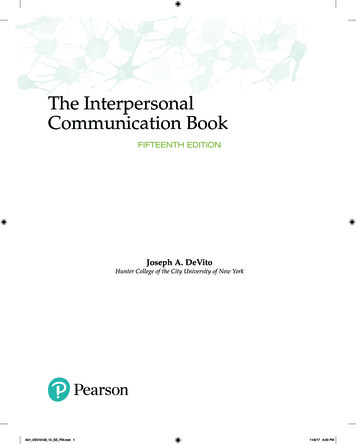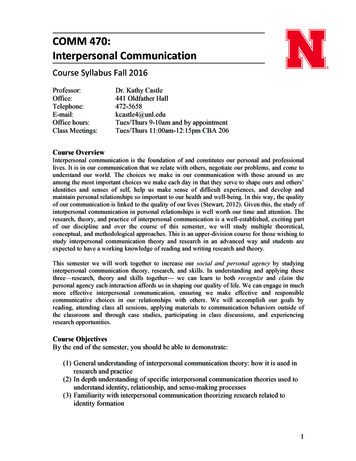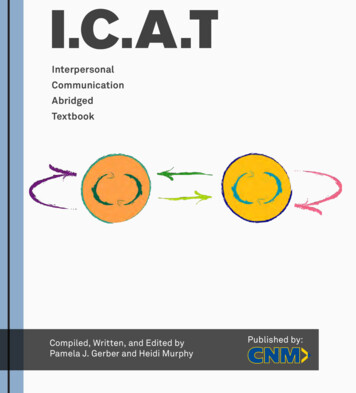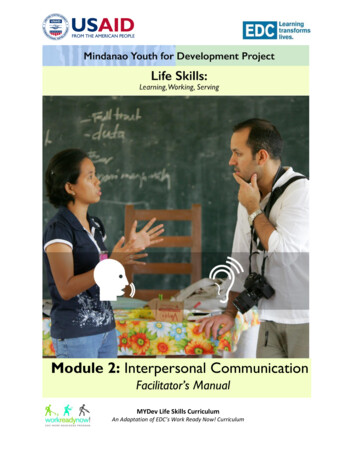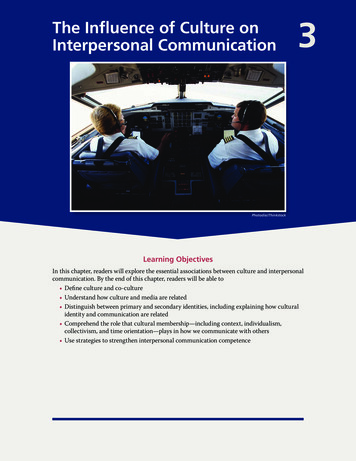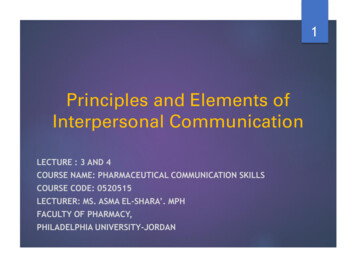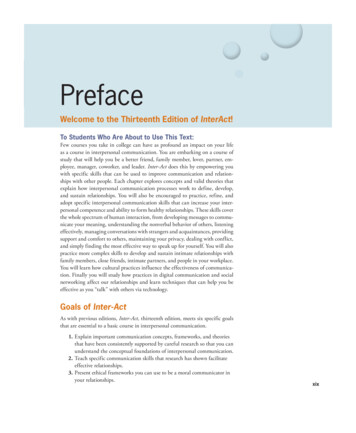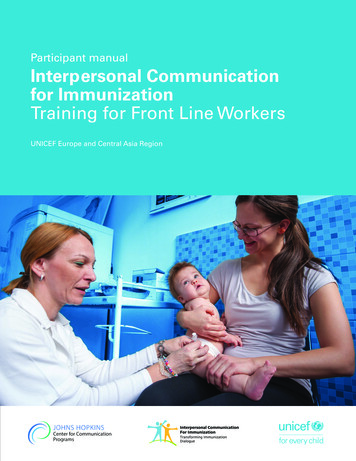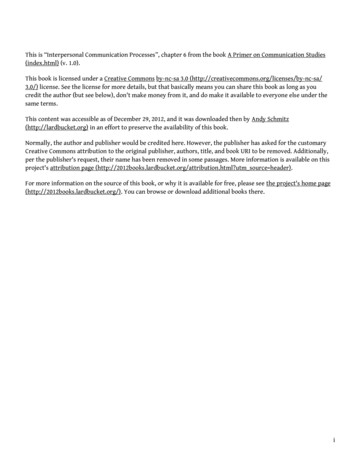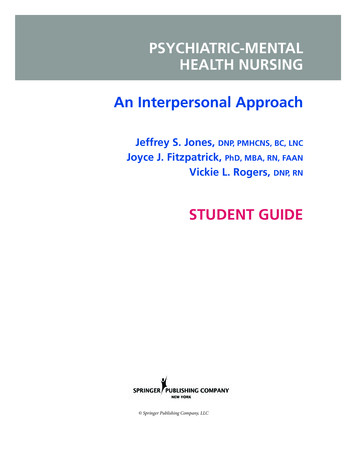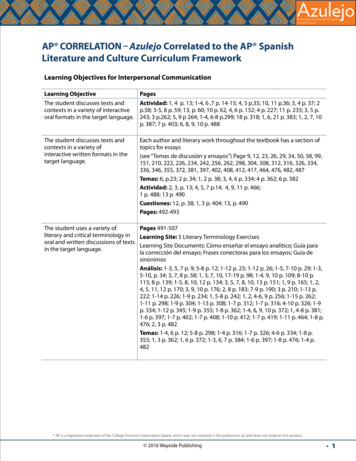
Transcription
AzulejoAnthology & Guide to the AP SpanishLiterature CourseAP CORRELATION – Azulejo Correlated to the AP SpanishLiterature and Culture Curriculum FrameworkLearning Objectives for Interpersonal CommunicationLearning ObjectivePagesThe student discusses texts andActividad: 1, 4 p. 13; 1-4, 6 ,7 p. 14-15; 4, 5 p.35; 10, 11 p.36; 3, 4 p. 37; 2contexts in a variety of interactivep.58; 3-5, 8 p. 59; 13, p. 60; 10 p. 62, 4, 6 p. 152; 4 p. 227; 11 p. 235; 3, 5 p.oral formats in the target language. 243; 3 p.262; 5, 9 p 264; 1-4, 6-8 p.299; 18 p. 318; 1, 6, 21 p. 383; 1, 2, 7, 10p. 387; 7 p. 403; 6, 8, 9, 10 p. 488The student discusses texts andcontexts in a variety ofinteractive written formats in thetarget language.Each author and literary work throughout the textbook has a section oftopics for essays(see “Temas de discusión y ensayos”) Page 9, 12, 23, 26, 29, 34, 50, 58, 99,151, 210, 222, 226, 234, 242, 256, 262, 298, 304, 308, 312, 316, 326, 334,336, 346, 355, 372, 381, 397, 402, 408, 412, 417, 464, 476, 482, 487Temas: 6, p.23; 2 p. 34; 1, 2 p. 38; 3, 4, 6 p. 334; 4 p. 362; 6 p. 382Actividad: 2, 3, p. 13; 4, 5, 7 p.14; 4, 9, 11 p. 466;1 p. 488; 13 p. 490Cuestiones: 12, p. 38; 1, 3 p. 404; 13, p. 490Pages: 492-493The student uses a variety ofPages 491-507literary and critical terminology inLearning Site: 5 Literary Terminology Exercisesoral and written discussions of textsLearning Site Documents: Cómo enseñar el ensayo analítico; Guía parain the target language.la corrección del ensayo; Frases conectoras para los ensayos; Guía desinónimosAnálisis: 1-3, 5, 7 p. 9; 5-8 p. 12; 1-12 p. 23; 1-12 p. 26; 1-5, 7-10 p. 29; 1-3,5-10, p. 34; 3, 7, 8 p. 58; 1, 3, 7, 10, 17-19 p. 98; 1-4, 9, 10 p. 109; 8-10 p.115; 8 p. 139; 1-5, 8, 10, 12 p. 134; 3, 5, 7, 8, 10, 13 p. 151; 1, 9 p. 165; 1, 2,4, 5, 11, 12 p. 170; 3, 9, 10 p. 176; 2, 8 p. 183; 7-9 p. 190; 3 p. 210; 1-13 p.222; 1-14 p. 226; 1-9 p. 234; 1, 5-8 p. 242; 1, 2, 4-6, 9 p. 256; 1-15 p. 262;1-11 p. 298; 1-9 p. 304; 1-13 p. 308; 1-7 p. 312; 1-7 p. 316; 4-10 p. 326; 1-9p. 334; 1-12 p. 345; 1-9 p. 355; 1-8 p. 362; 1-4, 6, 9, 10 p. 372; 1, 4-8 p. 381;1-6 p. 397; 1-7 p. 402; 1-7 p. 408; 1-10 p. 412; 1-7 p. 419; 1-11 p. 464; 1-8 p.476; 2, 3 p. 482Temas: 1-4, 6 p. 12; 5-8 p. 298; 1-4 p. 316; 1-7 p. 326; 4-6 p. 334; 1-8 p.355; 1, 3 p. 362; 1, 6 p. 372; 1-3, 6, 7 p. 384; 1-6 p. 397; 1-8 p. 476; 1-4 p.482* AP is a registered trademark of the College Entrance Examination Board, which was not involved in the production of, and does not endorse this product. 2016 Wayside Publishing 1
AzulejoAnthology & Guide to the AP SpanishLiterature CourseLearning Objectives for Interpretive CommunicationLearning ObjectivesPagesThe student reads andcomprehends literary and relatedwritten texts in thetarget language.Throughout the textbookThe student listens to andcomprehends spoken targetlanguage related toliterary content.Learning Site: 18 Listening audios for comprehension; Section Recursos:links for audios for the literary works; links for each author and several audioand video clipsActividad: 4 p. 13; 2, 3, 6-8 p. 14 ; 12 p. 60; 1, 2, 4, 6, 9 p. 317; 15 p. 318; 8, 9 p.384; 2 p. 466; 17 p. 467; 4, 10 p. 488.Cuestiones: 20 p. 154; 5 p. 228; 9 p.243.The student analyzes literary andEach author and literary work throughout the textbook has a section withrelated texts in the target language. questions for literary analysis of texts and relate texts (see “Sugerencias parael analisis”) Pages 9, 12, 23, 26, 29, 34, 49, 58, 98, 109, 115, 121, 127, 132, 139,144, 151, 165, 170, 173, 176, 183, 187, 190, 195, 202, 210, 222, 226, 234, 242,256, 262, 298, 304, 308, 312, 316, 326, 334, 336, 345, 355, 362, 372, 381, 397,402, 408, 412, 417, 464, 476, 482, 4872 The student differentiates betweenpersonal and critical reactions inthe target language.Temas: 6 p. 12; 4-6 p. 34; 4 p. 308; 5 p. 381; 1, 2, 4 p. 412Actividad: 5, 8 p. 14-15; 1-6 p. 16; 9 p. 36; 13 p. 60Cuestiones: 6 p. 61; 11 p. 62; 11, 12 p. 266; 3 p. 300The student identifies rhetoricalfigures used in targetlanguage texts.Pages: 491-507Análisis: 1-3, 5, 7 p. 9; 5-8 p. 12; 1-8 p. 58; 1, 7 p. 98; 1 p. 109; 3, 5 p. 115; 8-10p. 139; 10 p. 144; 1 p. 165; 1, 2, 4, 10, 11 p. 170; 10 p. 176; 3 p. 187; 3, 6 p. 210;1, 2, 4-9, 12, 13 p. 222; 1-5, 7-9, 11, 12 p. 226; 4, 8, 9 p. 234; 1, 2, 4, 5, 9 p. 256;1-4, 8, 10, 12-15 p. 262; 5, 7, 11 p.298; 1-3, 5, 8, 9 p. 304; 1-3, 6-13 p. 308; 1, 5-7p. 312; 1-5, 7 p. 316; 4 p. 326; 3, 5, 8, 9 p. 334; 5, 7, 8 p. 345; 1 p. 372; 3, 7, 8 p.381; 1, 3 p. 397; 2, 4, 7 p. 402; 2, 5, 7 p. 408; 1, 5-10 p. 412; 1, 3, 5, 7 p. 417; 10p. 464; 1, 3, 5-8 p.476; 5 p. 487Temas: 1-4, 6 p. 12; 4, 5 p. 226; 1, 2 p. 256; 4 p. 262; 6, 7 p. 298; 1, 2 p. 312; 2-6p. 326; 2-6 p. 355; 3, 4 p. 362; 1-3 p. 372; 3-5 p. 397; 2 p. 402; 4, 5 p. 464; 2, 3, 8p. 476; 1, 2 p. 482Learning Site: 5 literary terminology exercises 2016 Wayside Publishing
AzulejoAnthology & Guide to the AP SpanishLiterature CourseThe student analyzes thesignificance of rhetorical figures intarget language texts.Pages: 491-507Análisis: 1-3, 5, 7 p. 9; 5-8 p. 12; 1-8 p. 58; 1, 7 p. 98; 1 p. 109; 3, 5 p. 115; 8-10p. 139; 10 p. 144; 1 p. 165; 1, 2, 4, 10, 11 p. 170; 10 p. 176; 3 p. 187; 3, 6 p. 210;1, 2, 4-9, 12, 13 p. 222; 1-5, 7-9, 11, 12 p. 226; 4, 8, 9 p. 234; 1, 2, 4, 5, 9 p. 256;1-4, 8, 10, 12-15 p. 262; 5, 7, 11 p. 298; 1-3, 5, 8, 9 p. 304; 1-3, 6-13 p. 308; 1,5-7 p. 312; 1-5, 7 p. 316; 4 p. 326; 3, 5, 8, 9 p. 334; 5, 7, 8 p. 345; 1 p. 372; 3, 7, 8p. 381; 1, 3 p.397; 2, 4, 7 p. 402; 2, 5, 7 p. 408; 1, 5-10 p. 412; 1, 3, 5, 7 p. 417; 10p. 464; 1, 3, 5-8 p. 476; 5 p. 487Temas: 1-4, 6 p. 12; 4, 5 p. 226; 1, 2 p. 256; 4 p. 262; 6, 7 p. 298; 1, 2 p. 312; 2-6p. 326; 2-6 p. 355; 3, 4 p. 362; 1-3 p. 372; 3-5 p. 397; 2 p. 402; 4, 5 p. 464; 2, 3, 8p. 476; 1, 2 p. 482Learning Site: 5 literary terminology exercisesThe student identifies points ofview in target language texts.Análisis: 3 p. 9; 1 p. 49; 10 p. 109; 10, p. 298; 4, p. 402; 1 p. 476Temas: 1 p. 12; 3 p. 23; 3 p. 50; 1-4 p. 58Actividades: 7 p. 317; 4 p. 466Cuestiones: 2 p. 60; 8 p. 61; 9 p. 62; 12 p. 265; 13 p. 468; 3 p. 487; 4 p. 489; 7 p.490The student identifies stylisticfeatures of target language texts.In Análisis and Temas, per author and literary work, pages 9, 12, 23, 26, 29,34, 49-50, 58, 98-99, 109, 115, 121, 127, 132, 139, 144, 151, 165, 170, 176, 183,187, 190, 195, 202, 210, 222, 226, 242, 256, 262, 298, 304, 308, 312, 316, 326,334, 335, 345-46, 355, 362, 372, 381, 397, 402, 408, 412, 417, 464, 476, 482,487Learning Site: 5 literary terminology exercisesThe student analyzes thesignificance of stylistic features oftarget language texts.In Análisis and Temas, per author and literary work, pages: 9, 12, 23, 26, 29,34, 49-50, 58, 98-99, 109, 115, 121, 127, 132, 139, 144, 151, 165, 170, 176, 183,187, 190, 195, 202, 210, 222, 226, 242, 256, 262, 298, 304, 308, 312, 316, 326,334, 335, 345-46, 355, 362, 372, 381, 397, 402, 408, 412, 417, 464, 476, 482,487Learning Site: 5 literary terminology exercisesThe student identifies literarygenres, periods, movements, andtechniques and their characteristicsin target language texts.Pages: 3, 9-10, 18-20, 39-41, 50-51, 63-64, 100-104, 157, 213, 216-218, 223224, 230-31, 246-47, 257-58, 270-72, 273-74, 302, 305, 309, 312-314, 321, 32728, 337-38, 347-49, 363-64, 373, 389, 398, 409, 413-14, 419-20, 470-71, 477-78In Apendice II, Terminologia literaria, p. 497-507The student relates target language Análisis: 5-8, p. 12; 9 p. 34; 1, 5 p. 49; 19 p. 99; 2, 10 p. 109; 3 p. 151; 1, 9, 10 p.texts to genres, periods,234; 1, 6 p. 242; 7, 8 p. 308; 8 p. 326; 3, 5, 7-9 p. 334; 3-5, 8, 10, 11 p. 345; 1-8 p.movements, and techniques.381; 1, 2, 4, 11 p. 397; 1, 3, 5, 7 p. 417; 9 p. 476Temas: 2, 3 p. 9; 1, 2, 6 p. 12; 3 p. 26; 2, 3 p. 29; 1, 2, 4 p. 50; 3, 4 p. 58; 1, 2 p.99; 2-5 p. 210; 4-6 p. 222; 1-5 p. 226; 2, 6-11 p. 235; 1, 2, 6, 7 p. 242; 1, 4 p. 256;5-7 p. 263; 6, 7 p. 299; 2, 5, 7 p. 308; 1-7 p. 326; 6 p. 334; 1-5 p. 346; 5-8 p. 355;1-6 p. 372; 2-4 p. 381; 1-5 p. 397; 2, 3, 6 p. 412; 2-4, 7, 8 p. 464; 2-6 p. 476; 2-4p. 487. 2016 Wayside Publishing 3
AzulejoAnthology & Guide to the AP SpanishLiterature CourseThe student identifies socioculturalcontexts in target language texts.Análisis: 6 p. 29; 1 p. 115; 2-4, 7 p. 151; 5, 9 p. 127; 7 p. 137; 5, 10 p. 139; 2 p.195; 2-4 p. 210; 6, 7, 10 p. 234; 1-11 p. 256; 4-10 p. 298; 8 p. 326; 4 p. 334; 6, 7p. 397; 2-4 p. 408; 3, 4 p. 412; 1, 4, 6, 7 p. 417; 2-4, 11 p. 464Temas: 1, 2, 4, p. 9; 2-7 p. 256; 1-7 p. 262-3; 3 p. 298; p. 308; 1-7 p. 326; 1, 2 p.334; 3, 6 p. 372; 1-3, 6 p. 397.Actividad: 6-8, 14, 16 p. 317-318.Cuestiones: 2-9 p. 244; 1-6, 8-12 p. 265-266; 4-8, 10 p. 300; 2, 4, 5 p. 404; 2-8,12, 13 p. 489-490The student relates target language Análisis: 1-4 p. 12; 1-7 p. 262; 3, 4, 6, 7 p. 304; 4-6 p. 308; 5, 9, 11, 12 p. 345;texts to sociocultural contexts.1-3, 6-8 p. 362; 4, 5 p. 381Temas: 1, p. 304; 2-4, 6 p. 308; 2-4 p. 412; 1-4 p. 417; 3, 4, 7 ,8 p. 465Actividad: 1, 2, 7-9, 15, 16, 18 p. 382-3; 5, 7 p. 403; 5, 8, 10, 12, 13, 16, 18 p.466-7; 1-3, 6, 9-11 p. 488Cuestiones: 3, 4, 8-12 p. 319-20; 1, 2, 4-6, 9-12, 17-20 p. 385-387; 6-8, 11-13 p.405; 1-7, 9, 11-13, 15, 17 p. 468-9; 10, 11, 14-16 p. 490.The student situates textuallanguage and registers withinhistorical, social, andgeopolitical contexts.Temas: 1, 2, 7, p. 9; 1, 6 p.12; 1-4, p. 50; 2,5 p. 346Cuestiones: 1, 4, 6, 7, 9-15 p. 468Actividad: 1, 2, 7, 15, 16, 18, 19 p. 383The student relates artisticrepresentations and audiovisualmaterials, including films andmusic, to literary course content.Actividad: 1 p. 10; 5, 6, p. 13; 3, 6, 9 p. 14-15; 1-7, 8, 13, 15, p. 36; 3, 4, 10-13p. 38; 1 p. 59; 3, 6-8, 18-20 p. 151-154; 3, 4 p. 211; 1, 4, 6, 10, 13-15 p. 317; 2-5,8-11, 13, 19, 20, 22, 25, 26 p. 382-384; 20 p. 387; 2, 4 p. 403; 1, 2, 14, 17, 20 p.466; 4, p. 488Cuestiones: 1 p. 16; 1, 6 p. 37; 1, 4 p. 60; 1, 12 p. 155; 1, 2 p. 211; 1, 4-6, 9 p.228; 1 p. 244; 1 p. 265; 1, 3 p. 300; 1, 3 p. 318; 1-3, 5, 20 p. 385; 1 p. 404; 1 p.468; 1 p. 489The student relates secondary texts Temas: 3 p. 304to primary texts in support ofActividad: 6, 15 p. 35; 9 p. 59; 20 p. 154; 5 p. 211; 7 p. 243; 3, 6 p. 264; 9 p.textual analysis in the299; 14 p. 318; 13, 16, 24, p. 383; page 384; 1, 5, 8, 9, p. 403; 14 p. 466; 5 p.488target language.Cuestiones: 3 p. 37; 8 p. 61; 4, 6 p. 319; 13 p. 387The student uses authorizedreference tools for interpretingtexts in the target language.4 Page 327 2016 Wayside Publishing
AzulejoAnthology & Guide to the AP SpanishLiterature CourseLearning Objectives for Presentational CommunicationLearning ObjectivePagesThe student organizes information,concepts, and ideas in oral and written presentations inthe target language.Learning Site Documents: Cómo enseñar el ensayo analítico; Guía para lacorrección del ensayo, Frases conectoras para los ensayos; Guía de sinónimosLearning Site: Tests with essay, per Author and Unit, and other practicetestsThe student presents informationin a descriptive form inthe target language.Temas: 4 p. 9; 5 p. 23; 2, 4-6 p. 34; 5, 8 p. 99; 1-8 p. 151-152; 3, 6, 7 p. 262; 1,6 p. 334; 6 p. 372; 5, 7 p. 381; 2-5 p. 412; 3 p. 418Actividad: 2-4 p. 134; 5, 7, 8, 12, 13 p.14-15; 4, 5, 9-11, 14 p. 35; 3-8, 13 p. 59;1, 4, 5, 10, 11, 13-16 p. 152-154; 1, 3, 5-9 p. 211; 1, 4 p. 227; 3-6, 8 p. 243; 2-5,7, 9 p. 264; 1-8 p. 299; 3, 5-8, 10, 12, 18 p. 317; 1, 2, 6, 7, 10, 11, 14-16, 21, 23p. 382; 5, 7, 10 p. 403; 3-6, 8-15, 18, 19 p. 466; 1-3, 6, 8-11 p. 488.The student writes analytical compositions related to literary texts inthe target language.Pages: 492-493Temas: 6, p. 23; 2 p. 34; 1, 2 p. 38; 3, 4, 6 p. 334; 4 p. 362; 6 p. 382Actividad: 4, 9, 11 p. 466; 1 p. 488; 13 p. 490Cuestiones: 12, p. 38; 1, 3 p. 404; 13, p. 490“Temas para ensayos”, with each author and workLearning Site: 42 essays related to textsThe student creates and deliversoral presentations related to coursecontent in a variety of formats inthe target language.Temas: 6 p. 12Actividad: 1, 4 p. 13; 2, 4, 7 p. 14-15; 4, 5 p. 35; 10, 11 p. 36; 3, 4 p. 37; 2 p.58;8 p. 59; 13, p. 60; 10 p. 62, 4, 6 p. 152; 4 p. 227; 11 p. 235; 3, 5 p. 243; 3 p. 262;5, 9 p. 264; 1-4, 6-8 p. 299; 18 p. 318; 1, 2, 7, 10 p. 387; 1, 6, 21 p. 383; 7 p.403; 6, 8-10 p. 488The student incorporatesinformation from secondarysources related to texts in oral andwritten presentations inthe target language.Temas: 3 p. 304Actividad: 4-9, 13, p. 14-15; 6, 15 p. 35; 9 p. 59; 20 p. 154; 5 p. 211; 7 p. 243;3, 6 p. 264; 9 p. 299; 14 p. 318; 13, 16, 24, p. 383; page 384; 1, 5, 8, 9 p. 403;14 p. 466; 5, p. 488Cuestiones: 3 p. 37; 8 p. 61; 4, 6 p. 319; 13 p. 387The student uses authorizedreference materials in oral andwritten presentations.Throughout the bookActividad: 20, p.154: 7, 9 p. 243Cuestiones: 3 p. 229The student acknowledges sourcesand cites them appropriately.Opportunities to teach in research assignments and essays using sourcesfrom the learning site. 2016 Wayside Publishing 5
AzulejoAnthology & Guide to the AP SpanishLiterature CourseLearning Objectives for Cultures, Connections, Comparisons, and CommunitiesLearning ObjectivePagesThe student analyzes therelationship between products(both tangible and intangible) andperspectives of target cultures asmanifested in targetlanguage texts.Análisis: 2, 3 p. 34; 1, 3, 4, 6-8 p. 49; 7 p. 109; 1, 11 p. 115; 4 p. 121; 5 p. 127;8-11 p. 256; 16 p. 262; 2, 4, 10 p. 298; 5-7 p. 304; 5-7 p. 334; 11, 12 p. 345; 1,3, 7, 8 p. 362; 3, 8, 9 p. 372; 3 p. 412; 4-7 p. 417; 1-4, 11 p. 464; 9 p. 476; 1-4 p.482.Temas: 1, 3, 4 p. 9; 5 p. 23; 5, 6 p. 26; 2-4 p. 29; 2, 3, 5 p. 34; 1 p. 151; 1-4 p.226; 2-4 p. 242; 4-7 p. 256; 2, 4, 6 p. 308; 1, 2, 6 p. 326; 2, 3, 6 p. 372; 1-5 p.397; 2-5 p. 412; 1-4 p 417; 3, 4, 7, 8 p. 464; 4, 6 p. 476.Actividad: 4, 6 p. 13; 4, 5, 8 p. 14; 4 p. 35; 6 p. 59; 7 p. 243; 11 p. 235; 2-4 p.243; 5 p. 317; 5 p. 466.Cuestiones: 1-5 p. 16; 1, 2, 4 p. 37; 2, 3 p. 60; 1, 2, 4, 7 p. 228; 2-5, 8, 9 p. 244;2-6, 9, 10 p. 265; 4, 5, 7 p. 300; 3, 8-11 p. 319-20, 1, 4-6, 9, 11, 12, 18, 19 p. 3867; 2, 4, 5, 8, 9, 11-13 p. 404-5; 2-7, 11, 17 p. 468; 2-7, 9, 11-13, 16 p. 489-490.The student relates texts toActividad: 3-6, 8-10, 14 p. 14-15; 9, 10 p. 55;products and perspectives found in 1, 2, 9-12 p. 60; 1, 2, 7-10, p. 60-62; 19 p. 154; 6, 7 p. 403; 7 p. 466a variety of media from theCuestiones: 1 p. 211; 3 p. 385; 1 p. 489target cultures.The student analyzes therelationships between practicesand perspectives of target culturesas manifested in targetlanguage texts.Análisis: 2, 3 p. 34; 1, 3, 4, 6-8 p. 49; 7 p. 109; 1, 11 p. 115; 4 p. 121; 5 p. 127;8-11 p. 256; 16 p. 262; 2, 4, 10 p. 298; 5-7 p. 304; 5-7 p. 334; 11, 12 p. 345; 1,3, 7, 8 p. 362; 3, 8, 9 p. 372; 3 p. 412; 4-7 p. 417; 1-4, 11 p. 464; 9 p. 476; 1-4 p.482.Temas: 1, 3, 4 p. 9; 5 p. 23; 5, 6 p. 26; 2-4 p. 29; 2, 3, 5 p. 34; 1 p. 151; 1-4 p.226; 2-4 p.242; 4-7 p. 256; 2, 4, 6 p. 308; 1, 2, 6 p. 326; 2, 3, 6 p. 372; 1-5 p. 397;2-5 p. 412; 1-4 p 417; 3, 4, 7, 8 p. 464; 4, 6 p. 476.Actividad: 4, 6 p. 13; 4, 5, 8 p. 14; 4 p. 35; 6 p. 59; 7 p. 243; 11 p. 235; 2-4 p.243; 5 p. 317; 5 p. 466Cuestiones: 1-5 p. 16; 1, 2, 4 p. 37; 2, 3 p. 60; 1, 2, 4, 7 p. 228; 2-5, 8, 9 p. 244;2-6, 9, 10 p. 265; 4, 5, 7 p. 300; 3, 8-11 p.319-320; 1, 4-6, 9, 11, 12, 18, 19 p.386-387; 2, 4, 5, 8, 9, 11-13 p. 404-405; 2-7, 11, 17 p. 468; 2-7, 9, 11-13, 16 p.489-490The student relates texts topractices and perspectives found ina variety of media from thetarget cultures.Actividad: 2-10, 13, 14 p.14-15; 1-8, 15 p. 35; 1, 3, 4, 8-12 p. 59; 2-4, 6, 8, 12,18-20 p.153; 1, 2, 4, 5 p.211; 3, 4 p. 227; 1-9 p. 243; 1, 2, 3, 5, 6 p. 264; 1, 2, 4, 6,7, 9, 10, 13-16 p. 317; 1-5, 7-13, 15, 16, 19-22, 24-26 p. 382; 1-9, 11 p. 403; 1, 2,6, 7, 10, 12-14, 17, 20 p. 466; 1-7, 10, 11 p. 488Cuestiones: 1-3 p. 16; 1, 2, 7, 11 p. 37; 1-8 p. 60; 1, 3, 5, 7-9, 11, 17 p.155; 1, 2,3, 8 p. 212; 1, 2, 4-6, 9 p.228; 1, 3 p. 244; 1, 3, 7 p. 269; 1, 3 p. 300; 1, 3, 4, 6 p.319; 1-3, 5, 13, 20, 21 p. 385; 1, 3, 6, 9 p. 404; 1, 9, 10, 16 p. 468; 1-15 p. 489.The student analyzes the role ofActividad: 5-9 p. 211; 6 p. 382; 9 p. 466; 20 p. 467personal assumptions andCuestiones: 3-5 p. 16; 6 p. 91; 12 p. 266; 4-6 p. 300; 9-12 p. 320; 1, 2, 4-6, 9,cultural beliefs in the interpretation 10, 12, 13, 19, 20 p. 385; 8 p. 405; 2, 7, 16, 17 p. 468of target language texts.6 2016 Wayside Publishing
AzulejoAnthology & Guide to the AP SpanishLiterature CourseThe student situates texts withinliterary and artistic heritages of thetarget cultures.Pages: 3, 9-10, 18-20, 39-41, 50-51, 63-64, 100-104, 157, 213, 216-218, 223224, 230-231, 246-247, 257-258, 270-272, 273-274, 302, 305, 309, 312-314,321, 327-328, 337-338, 347-349, 363-364, 373, 389, 398, 409, 413-414, 419420, 470-471, 477-478The student relates literarymovements to cultural contexts.Pages relating to the literary and cultural background of texts: 3, 9-10, 18-20,39-41, 50-51, 63-64, 100-104, 157, 213, 216-218, 223-224, 230-231, 246-247,257-258, 270-272, 273-274, 302, 305, 309, 312-314, 321, 327-328, 337-338,347-349, 363-364, 373, 389, 398, 409, 413-414, 419-420, 470-471, 477-478Análisis: 3 p. 12; 1, 6 p. 49; 9, 10 p. 234Temas: 1, 6 p. 12; 5, 6 p. 23; 3, 6 p. 23, 2, 4 p. 29; 3, 4 p. 50; 1, 4, 5 p. 99; 2, 4, 6p. 222; 2, 3, 4 p. 226; 8-11 p. 234; 5-7 p. 262; 2 p. 308; 2 p. 312Actividad: 3-5, 8-10 p. 15; 1, 4, 5, 7 p. 35; 8, 9, 12 p. 59; 1, 2, 10, 20 p. 152-154;3 p. 227; 4-6 p. 243; 5 p. 264; 7 p. 317; 3, 9, 10 p. 319; 1, 2, 7, 8, 15, 16, 21 p.382; 1, 2, 3 p. 403; 1, 6, 7, 11, 12 p. 466; 1-3, 6, 9 p. 488Cuestiones: 3, 5 p. 16; 1, 4, 11 p. 37; 1, 2, 8 p. 61; 1-3, 5, 7, 11, 17 p. 155; 1, 3-7p. 211; 2-7 p. 228; 1-3, 5, 8, 9, 13 p. 244; 1, 3, 7 p. 265; 7, 8 p. 301; 1, 4-6, 12, 20p. 385; 1, 2, 4, 5, 11-13 p. 404; 1, 6, 7, 11, 17 p. 468; 1, 5, 6-9, 11, 12, 15, 16 p.489The student analyzes how textsreinforce or challenge perceptionsof a majority culture.Análisis: 7 p. 417Temas: 2, 4-6 p. 34; 2 p.58; 1-3 p. 49; 3, 4 p. 50Actividad: 9 p. 36; 2, 3, 6, 7 p. 59; 2, 5-7, 9, 11 p. 155; 4 p. 210; 5-7 p. 234; 9 p.264: 3, 4 p. 243; 7, 14, 16 p. 317; 1-4 p. 417; 3-6, 10-12, 18 p. 466Cuestiones: 4, 5, 12, 13 p. 37; 1-4, 8 p. 60-62; 1-6 p. 265; 8, 10, 11 p. 320; 17,18 p. 387; 3, 5, 6, 9-13 p.468; 7-11 p. 490; 9-13 p. 469The student relates texts to theircontexts (literary, historical,sociocultural, geopolitical) inthe target language.Pages: 1-3, 17-21, 24, 26, 27, 30-31, 39-41, 50, 51, 63-4, 100-104, 157-158,213-218, 219-20, 223-224, 230-231, 236-237, 246-247, 267-272, 273-274,302-303, 305-306, 309-310, 312-314, 321, 327-328, 337-338, 347-349, 363365, 373, 389, 398, 406-407, 409, 413-414, 419-420, 470-471, 477-478Actividad: 12 p. 153; 1-3, 6, 9, 11 p. 488Cuestiones: 1-4 p.60; 6 p. 212; 9 p. 229; 2, 3, 5, 7-10 p. 244; 1-12 p. 265; 1, 4,5, 18, 19 p. 385; 1, 3-6, 9-14 p. 468; 1, 5-7, 10, 11, 14, 15 p. 490The student makes interdisciplinary Actividad: 7 p. 243; 1-26 p. 382-384; Unidad 4 p. 403-405; 1, 2, 7, 12-14, 20 p.connections to support analysis of 466; Unidad 6 p.488literary and related texts.Cuestiones: 5, 6 p. 228; 18-20 p. 154; 1-7, 21 p. 385; 6 p. 152; 7 p. 153; 1, 3, 6,8 p. 404The student relates texts tocontemporary global issues usingthe target language.Temas: 7 p. 152; 2 p. 308Actividad: 2, 6 p. 16; 9 p. 36; 1, 3 p. 243; 2, 3, 5, 8, 9 p. 264; 1, 4, 5 p. 299; 7, 8,14, 16 p. 318; 1, 2 p. 382; 4, 5, 7, 10, 11 p. 403-404; 5, 6, 8, 10-12, 16 p. 466467; 1, 3, 5, 6, 9, 11 p. 488Cuestiones: 9, 11 p. 38; 9-11 p. 61; 2, 11 p.155; 6 p. 212; 5, 8 p. 244; 3-8, 10-12p. 265-266; 3-7 p. 300-301; 1, 4, 9-12 p. 319-20; 1, 2, 4, 5, 20, 22 p. 385-388; 4,6-8, 13 p. 404-5; 4, 6, 7, 11, 13, 16, 17 p. 468-469; 1, 5-12, 14, 15 p. 490 2016 Wayside Publishing 7
AzulejoAnthology & Guide to the AP SpanishLiterature CourseThe student uses informationavailable in the target languageand culture to support theinterpretation of texts and comparedistinctive viewpoints.Actividad: 2-11, 13 p. 14-15; 1, 4-8, 12, 13, 15 p. 35; 1, 9, 12 p. 59; 1, 4, 8, 19,20 p. 153; 4, 5 p. 211; 4-9 p. 243; 1-3, 6 p. 264; 7, 9 p. 299; 1, 4, 7, 9, 10, 14, 15p. 317; 1, 2, 4, 8, 9, 13, 16, 19, 20, 24-26 p. 382; 6, 8, 9 p. 403; 1, 2, 6, 7, 12, 13,17 p. 466; 1-4, 6, 7, 10 p. 488Cuestiones: 4, 5 p. 16; 1, 3, 5, 8 p. 37; 1, 4, 8, 9 p. 61; 1, 3, 6, 9, 12, 17 p. 156; 1,8, 9 p. 211; 8, 9, 13, 14 p. 246; 5-7 p. 265; 1, 8 p. 300; 4, 7 p. 319; 1, 5, 13, 20 p.385; 1,6 p. 404; 1, 4, 7, 10, 14, 15 p. 468; 1, 3-5, 7, 9, 11, 15 p. 489The student compares literaryfeatures of target language texts tothose of other texts.Temas: 5, 6 p. 9; 3 p. 26; 3 p. 29; 3 p. 34; 3 p. 58; 4 p. 58; 12 p. 144; 2, 5 p. 222;2-4 p. 226; 6, 7 p. 242; 6 p. 263; 3, 4 p. 304; 7 p. 308; 4 p. 336; 4, 5 p. 346; 3 p.381; 4, 6 p. 397; 2 p.402; 2, 3 p. 408; 5 p. 412; 1-4 p. 417; 8 p. 476; 5 p. 487Actividad: 5 p. 211; 6 p. 264; 17, 24 p. 383; 1 p. 403; 14 p. 466; 7 p. 488Cuestiones: 4, 6, 8, 9, 11, 16 p. 155-156; 8, 9 p. 212; 6, 7, 12 p. 245; 7, 9 p. 299;11 p. 301; 2 p. 319; 8 p. 320; 19, 21 p. 387; 3, 5 p. 404; 2, 12 p. 468; 2, 4 p. 489;13 p. 490The student compares textuallanguage and registers in targetlanguage texts produced indifferent historical, social, andgeopolitical contexts.Temas: 1, 5 p. 9; 4, 5 p. 34; 1 p. 50Actividad: 5 p. 13; 5, 6 p. 14; 4 p. 152; 6 p. 152; 1 p. 243; 6 p. 466Cuestiones: 4, 5 ,6 p. 37; 8 p. 59; 7 p. 155; 7 p. 229; 10 p. 235; 14 p. 387; 9 p.405The student compares culturalTemas: 1-3, 7 p. 9; 2, 6 p. 34; 3 p. 262products, practices, or perspectives Actividad: 3, 8, 9 p. 35; 1, 4, 10, 15 p. 152; 7 p. 211; 4, 6 p. 227; 1, 3 p. 243; 1,portrayed in texts to his or her own. 4-6 p. 299; 2, 12 p. 317; 6, 14, 23 p. 382-383; 4, 5, 10, 11 p. 403; 5, 6, 8-11, 16,19, 20 p. 466; 6, 8, 10 p. 488Cuestiones: 11 p. 38; 9, 14 p. 36; 6 p. 91; 9 p. 245; 12 p. 266; 4-6 p. 300; 9-12p. 320; 8 p. 405; 6, 7, 9 p. 469; 14, 16 p. 488; 8 p. 4908 The student comparesrepresentations of key eventsproduced through a variety ofcultural perspectives.Análisis: 5 p. 58; 2, 4 p. 121; 8 p. 139; 5, 6 p. 234; 9 p. 298Temas: 4 p. 50; 2 p. 58; 1, 2 p. 228; 3 p. 226; 2 p. 346Actividad: 4 p. 152; 5 p. 243; 2, 5, 6 p. 382; 4, 5, 6, 11 p. 403; 7 p. 466; 4 p. 488Cuestiones: 1-6 p. 16; 3 p. 34; 1 p. 37; 1, 2, 4, 5, 8 p 60-61; 1, 13, 17 p. 155156; 1, 5, 6 p. 228; 14 p. 245; 1 p. 265; 3 p. 300; 2, 3, 22 p. 385; 1 p. 404; 1, 8, 9,14, 16 p. 468The student deepens andreinforces understanding of literarytexts through activities in the targetlanguage within and beyond theclassroom setting.Actividad: 1-14 p. 14-15; 1-15 p.35-36; 1-13 p. 60; 1-20 p. 152-153; 1-9 p.210; 1-6 p. 227; 1-10 p. 243; 1-9 p. 264; 1-9 p. 299; 1-18 p. 317-318; 1-26 p.382-384; 1-20 p. 466-7; 1-11 p. 488Cuestiones: 1-13 p. 38; 1-11 p. 61-62; 1-17 p. 155-156; 1-10 p. 211-212; 1-9 p.228-229; 1-14 p. 244-245; 1-12 p. 265-266; 1-14 p. 300-301; 1-12 p. 318-320;1-22 p. 385-388; 1-11 p. 403-404; 1-13 p. 404-405; 1-17 p. 468-469; 1-16 p.489-490The student shares knowledge ofliterature and culture withcommunities beyond theclassroom setting.Actividad: 14 p. 490; 10 p. 488 2016 Wayside Publishing
AzulejoAnthology & Guide to the AP SpanishLiterature CourseLearning Objectives for Language Usage in Support of Literary AnalysisLearning ObjectivePagesThe student uses a variety ofvocabulary appropriate toliterary analysis.Throughout the bookLearning Site: Autoprueba de vocabularioThe student uses a variety ofgrammatical andsyntactic structures.In essays, throughout the bookLearning Site: Essays (free Response) on each of 36 authorsThe student producescomprehensible written work byobserving writing conventions ofthe target language.Throughout the bookLearning Site: Essays (free Response) on each of 36 authorsLearning Site Documents: Cómo enseñar el ensayo analítico; Guía parala corrección del ensayo, Frases conectoras para los ensayos; Guía desinónimosThe student uses pronunciationthat is comprehensible to theaudience in oral communications.In oral presentations, throughout the bookThe student self-monitors andLearning Site: Guía para la corrección del ensayoadjusts language production in oraland written communications. 2016 Wayside Publishing 9
AzulejoAnthology & Guide to the AP SpanishLiterature Course10 2016 Wayside Publishing
Learning Objectives for Interpersonal Communication Learning Objective Pages The student discusses texts and contexts in a variety of interactive . Each author and literary work throughout the textbook has a section with questions for literary analysis of texts and relate texts (see "Sugerencias para el analisis") Pages 9, 12, 23, 26, 29 .
